Philippine presidential inauguration

The inauguration of the President of the Philippines is a ceremonial event marking the commencement of a new six-year term of a President of the Philippines. The day a presidential inauguration occurs is June 30 as mandated by the 1987 Philippine Constitution. Under the previous 1935 Constitution, the date was December 30, which is also Rizal Day; the last inauguration to take place on the older date was Ferdinand Marcos' second one on December 30, 1969. The most recent public presidential inauguration ceremony, the swearing in of President Rodrigo Duterte to begin his six-year term in office, took place on Thursday, June 30, 2016.
The only inauguration element mandated by the Philippine Constitution is that the president make an oath or affirmation before that person can "enter on the Execution" of the office of the presidency. However, over the years, various traditions have arisen that have expanded the inauguration from a simple oath-taking ceremony to a day-long event, including parades, speeches, and balls.
When a new president takes over mid-term due to the death or resignation of a president, the oath of office is administered but formal, public inauguration events have not been held.
Inauguration Rites

The ceremony since 1992 traditionally begins with the President-Elect fetching the incumbent in Malacañan Palace on the morning of June 30. At the Palace's State Entrance, the President-Elect will wait for the incumbent to descend the Grand Staircase. Upon meeting at the foot of the staircase, the President-Elect would greet the incumbent.
Both travel to the Quirino Grandstand aboard any of the Presidential cars. Following protocol, the outgoing President takes the back right-hand seat of the vehicle, while the President-Elect is seated behind the chauffeur. At the Grandstand's parade grounds, the outgoing President will be welcomed with arrival honours, and then shake hands with the President-Elect. The outgoing President conducts a final troop review and is presented to the public before departing the Grandstand aboard their own private vehicle. Only Corazón Aquino broke with the custom of leaving the Grandstand immediately, choosing instead to stay until the end of Fidel Ramos's inaugural speech.
The inauguration proper then begins with the singing of the National Anthem. An ecumenical Invocation follows, led by leaders of the different major religions of the Philippines, followed by a patriotic musical piece by a musical ensemble. Since the Third Republic, the Vice-President-Elect is sworn in before the President-Elect to immediately secure the line of succession. During his inauguration, President Manuel L. Quezon took the Oath of Office first to mark a "new start".[1]
As mandated by the Constitution, the President-Elect then takes the Oath of Office at exactly 12:00 PST (GMT+8); in 2010, President-Elect Aquino did not await noon, instead taking his Oath moments after Vice-President-Elect Binay finished doing so. The Oath is customarily administered by the Chief Justice of the Supreme Court of the Philippines, but that is not required.[2] Due to political differences, Benigno Aquino III instead had then-Associate Justice Conchita Carpio-Morales administer the Oath instead of then-Chief Justice Renato Corona. A 21-gun salute is then immediately fired, followed by four ruffles and flourishes and the Presidential Anthem, We Say Mabuhay, is played in honour of the new President.
The new President then delivers an Inaugural Address. Previous inaugurations also saw a full military and civil parade in the same manner as the Independence Day celebrations on 12 June (similar to the US Inaugural Parades) right after the address. From the late 1940s to the late 1960s, similar parades were also held on Rizal Day on 30 December as well and to ring in the New Year's celebrations that would start the day after.
The new President then returns to Malacañan Palace to formally take possession of the residence.[3] This formal entry is symbolised by the President ascending the Grand Staircase and proceeding to the Ceremonial Hall. Juan Luna's painting, The Blood Compact, is currently displayed at the top of the Staircase. The President then inducts the new Cabinet on the same day, and holds its first meeting immediately after.
In the evening, an Inaugural Reception is held for other officials and foreign dignitaries who wish to call on the new President. The customary banquets of either a vin d'honneur or an Inaugural Ball were abolished, in an effort to revert to the pre-Martial Law practise of simpler official receptions. The last Inaugural Ball was held in 1981 for Ferdinand Marcos' third inauguration, which was also the last time the Rigodon de Honor (a Hispanic dance analogous to a court dance) was performed; it was again danced on Independence Day of 2009. The President concludes the ceremonies with a toast, as a gesture of amity towards states that maintain diplomatic ties with the Philippines.[4]
Date
The new President is to be inaugurated at noon of June 30 as currently mandated by the 1987 Constitution, but past ceremonies were held on different dates.[5] The first President, Emilio Aguinaldo, was inaugurated on January 23, 1899, while Presidents under the 1935 Constitution were inaugurated at noon of Rizal Day (December 30). Only two Presidents under the 1935 Constitution were not inaugurated on December 30, namely, Sergio Osmeña and Manuel Roxas. Ferdinand Marcos changed the inauguration date to the present June 30, while his successors Corazon Aquino and Gloria Macapagal-Arroyo were inaugurated on February 25, 1986 and January 20, 2001, respectively, Aquino after the EDSA Revolution and Arroyo after the EDSA II.
Location

Seven inaugurations have been held at the Quirino Grandstand in the Luneta, namely, Quirino (1949), Magsaysay (1953), Garcia (1957), Macapagal (1961), Marcos (1965, 1969, 1981), Ramos (1992) and Aquino III (2010).[6] Presidents Estrada and Arroyo only delivered their inaugural addresses there. To date, Estrada and Arroyo were the only presidents to take the oath of office and inaugural addresses in two different locations.
Other presidents, namely Aguinaldo and Estrada, were inaugurated at the Barasoain Church in Malolos, Bulacan; Quezon, Laurel and Roxas were inaugurated in front of the Legislative Building; and Aquino in Club Filipino, Greenhills, San Juan, Metro Manila.[7] Marcos was inaugurated in Maharlika Hall, Malacañan Palace in 1986; and Duterte inaugurated in the Rizal Hall, Malacañan Palace in 2016. Arroyo took her first oath as president at the EDSA Shrine in Quezon City. Osmeña, who assumed the presidency upon the death of his predecessor Manuel L. Quezon, took his oath of office in Washington D.C. Quirino and Garcia took the oath of office in the Malacañan Palace.
Attendees
In addition to the general public the following are the attendants of the Inauguration:
- The President and Vice-President-elects and their families
- Members of Congress
- Members of the President's Cabinet
- Justices of the Supreme Court
- Local Officials
- Representatives of Different Countries and Organisations
- usually the outgoing President and Vice-President
- Choir, orchestra, and other musical performers
- Representatives of the various religions of the country
- Security, headed by the Presidential Security Group
- Military band and Honor guard from the Armed Forces of the Philippines
If a civil-military parade follows the speech the format is the same as in the Independence Day parades, with the AFP first, with the units of the Philippine National Police, Bureau of Fire Protection and the Philippine Coast Guard following them and later by civilian marchers representing the government, private sector, youth uniformed organizations and the representatives of the nation's various ethnic nationalities.
Ceremonial
Oath of Office
Under Article VII, Section 5 of the 1987 Constitution, before the President-Elect and Vice-President-Elect enters into the execution of their offices, the President shall take the following oath or affirmation:
| “ | I,_______________, do solemnly swear [or affirm] that I will faithfully and conscientiously fulfill my duties as President [or Vice-President or Acting President] of the Philippines, preserve and defend its Constitution, execute its laws, do justice to every man, and consecrate myself to the service of the Nation. So help me God.
[In case of affirmation, last sentence will be omitted.] |
” |
The oath from the Filipino version of the Constitution was used for the inaugurations of Presidents Fidel V. Ramos, Joseph Estrada and Benigno Aquino III:
| “ | Ako, si_______________, ay taimtim kong pinanunumpaan [o pinatotohanan] na tutuparin ko nang buong katapatan at sigasig ang aking mga tungkulin bilang Pangulo [o Pangalawang Pangulo o Nanunungkulang Pangulo] ng Pilipinas, pangangalagaan at ipagtatanggol ang kanyang Konstitusyon, ipatutupad ang mga batas nito, magiging makatarungan sa bawat tao, at itatalaga ang aking sarili sa paglilingkod sa Bansa. Kasihan nawa ako ng Diyos.
[Kapag pagpapatotoo, ang huling pangungusap ay kakaltasin.][8] |
” |
Inaugural Address
| Wikisource has original text related to this article: |
Every president since Emilio Aguinaldo delivered an inaugural address. Presidents, who became president upon the death of their predecessor, also delivered an address. It is usually delivered after the new president took the oath of office. However, President Gloria Macapagal-Arroyo delivered the inaugural address first at the Quirino Grandstand and then took the oath of office in Cebu.[9]
Gallery
 Inauguration of President Manuel Quezon, 1935.
Inauguration of President Manuel Quezon, 1935. Inauguration of President Jose P. Laurel, 1943.
Inauguration of President Jose P. Laurel, 1943.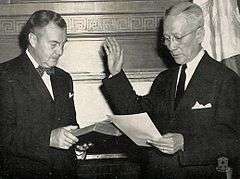 Inauguration of President Sergio Osmeña, 1944.
Inauguration of President Sergio Osmeña, 1944. Second Inauguration of President Manuel Roxas, 1946.
Second Inauguration of President Manuel Roxas, 1946. First Inauguration of President Elpidio Quirino, 1948.
First Inauguration of President Elpidio Quirino, 1948. Second Inauguration of President Elpidio Quirino, 1949.
Second Inauguration of President Elpidio Quirino, 1949.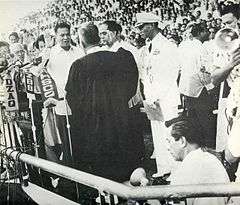 Inauguration of President Ramon Magsaysay, 1953.
Inauguration of President Ramon Magsaysay, 1953. First Inauguration of President Carlos P. García, 1957.
First Inauguration of President Carlos P. García, 1957.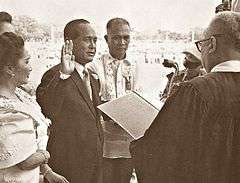 Second Inauguration of President Carlos P. García, 1957.
Second Inauguration of President Carlos P. García, 1957. Inauguration of President Diosdado Macapagal, 1961.
Inauguration of President Diosdado Macapagal, 1961.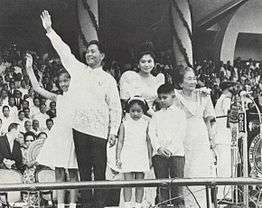 First Inauguration of President Ferdinand Marcos, 1965.
First Inauguration of President Ferdinand Marcos, 1965.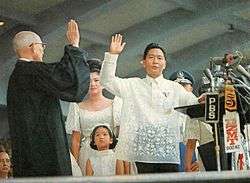 Second Inauguration of President Ferdinand Marcos, 1969.
Second Inauguration of President Ferdinand Marcos, 1969.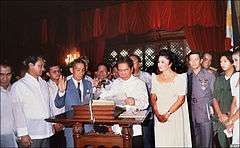 Fourth Inauguration of President Ferdinand Marcos, 1986.
Fourth Inauguration of President Ferdinand Marcos, 1986. Inauguration of President Corazon Aquino, 1986.
Inauguration of President Corazon Aquino, 1986. Second Inauguration of President Gloria Macapagal-Arroyo, 2004.
Second Inauguration of President Gloria Macapagal-Arroyo, 2004. Inauguration of President Benigno Aquino III, 2010.
Inauguration of President Benigno Aquino III, 2010. Inauguration of President Rodrigo Duterte, 2016.
Inauguration of President Rodrigo Duterte, 2016.
List of inaugural ceremonies
Note: Vice President-elects usually take the oath of office with the President-elect, but Rodrigo Duterte broke tradition by requesting Vice President-elect Leni Robredo to hold inauguration rites separately.[10] The only other instances that the Vice President was inaugurated separately, when Gloria Macapagal-Arroyo succeeded to the presidency and nominated Teofisto Guingona as Vice President. Guingona was confirmed by Congress on February 9, 2001 and took the oath of office the same day.
References
- ↑
- ↑ Quezon III, Manuel L. "Notes for the coming inaugural". The Long View. Retrieved 28 June 2010.
- ↑ The Possession of Malacañan Palace, Presidential Museum and Library, June 30, 2012
- ↑
- ↑
- 1 2 3 4 5 6 7 8 9 10 11 12 13 14 The Protocol, Ceremony, History and Symbolism of the Presidential Inauguration on the Presidential Museum and Library
- ↑ Quezon III, Manuel L. "Notes for the coming inaugural".
- ↑ ANG 1987 KONSTITUSYON NG REPUBLIKA NG PILIPINAS, Center for Southeast Asian Studies, Northern Illinois University
- ↑
- ↑ http://www.philstar.com/headlines/2016/06/17/1593848/separate-inauguration-first-recent-history
- ↑ Individual named is the Chief Justice, unless otherwise indicated
- ↑ The Commonwealth oath of office included a pledge of allegiance to the sovereignty of the United States
- ↑ When the independence of the Philippines was recognized on July 4, 1946, Roxas retook his oath of office again, without the pledge of allegiance, as befits the president of a sovereign nation
- ↑ Upon the death of Manuel Roxas
- ↑ Upon his election in 1949
- ↑ Upon the death of Ramon Magsaysay
- ↑ Upon his election in 1957
- ↑ Confirmed as Prime Minister
- ↑ Upon certification of COMELEC
- ↑ Upon certification of NAMFREL
- ↑ Upon the culmination of EDSA II
- ↑ Upon her election in 2004
- ↑ Kitty Duterte to hold Bible of Duterte's mother for oath-taking, Pia Randa, Rappler, June 27, 2016
External links
- Philippine Presidential Inaugurations on the Official Gazette
- The Protocol, Ceremony, History and Symbolism of the Presidential Inauguration on the Presidential Museum and Library
- Inauguration of President Aquino and past Philippine Presidents